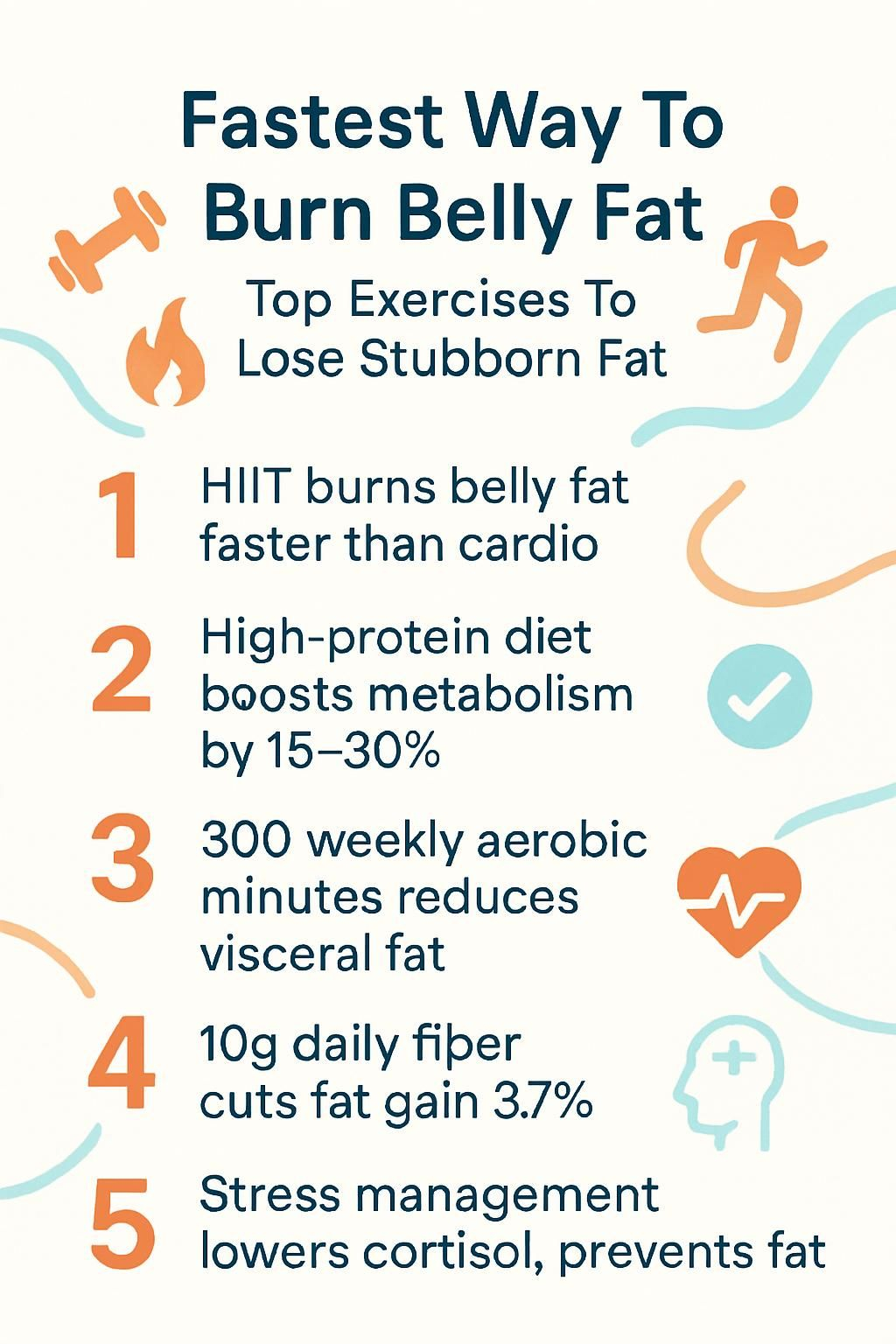Fastest Way To Burn Belly Fat: Top Exercises To Lose Stubborn Fat
Our Nutrition Assistant AI Suite will transform your body. You will lose fat, get toned, and build muscle. Gain confidence and optimal health.
If stubborn fat around your belly will not budge, you are not alone. Extra belly fat raises the risk of heart disease, type 2 diabetes, and other serious conditions. This guide explains why belly fat is hard to lose, which exercises help you lose belly fat faster, and the lifestyle habits that make the biggest difference. You will leave with clear steps that fit real life.
Key Takeaways
- High-intensity interval training, or HIIT, burns more calories and reduces both visceral and subcutaneous belly fat faster than steady cardio, based on Maillard F. (2018).
- A high protein diet increases fullness, raises metabolic rate by about 15–30 percent, and protects muscle during weight loss, shown in Moon J et al. (2020).
- Postmenopausal women doing 300 minutes of aerobic exercise each week lost more total and visceral fat than those doing 150 minutes, reported in 2015 research.
- Cutting sugary drinks and processed foods while adding at least 10 grams of soluble fiber daily can reduce belly fat gain by up to 3.7 percent over five years.
- Managing stress with yoga or meditation helps lower cortisol, the main stress hormone, which can reduce abdominal weight gain; Warne JP et al. (2009) links high stress with higher obesity risk.

Understanding Different Types of Belly Fat

Belly fat is not all the same. Each type affects your health in different ways. Knowing the difference helps you choose smart ways to lose excess belly fat and get fit.
What Is the Difference Between Visceral and Subcutaneous Fat?
Subcutaneous fat lies just under your skin. You can pinch it around your waist, thighs, or hips. Visceral fat sits deeper in your abdomen and surrounds organs like the liver and pancreas.
Visceral fat carries greater health risk. A waist over 35 inches for women or 40 inches for men raises the odds of high blood pressure, unhealthy cholesterol, sleep apnea, and certain cancers.
You may notice subcutaneous fat first because it is visible. Yet excess visceral belly fat is more harmful to your health. During my own cut after college, losing surface fat improved how my clothes fit. Dropping visceral fat gave me more energy and better blood work.
Reducing this deep fat calls for focused diet and exercise. Cutting it lowers your chances of type 2 diabetes and heart disease. Knowing why stubborn belly fat hangs on sets you up for the best exercises next.
Why Is Belly Fat So Difficult to Lose?
Your body stores belly fat for energy. Genetics and hormones can make this area stubborn. Aging slows metabolism and reduces muscle mass, so you burn fewer calories each day. Even if your scale number stays the same, you may see more belly fat over time.
Lower estrogen after menopause shifts fat storage to the abdomen for many women. Family traits matter too. Some people store extra adipose tissue in the midsection no matter their weight or activity level.
Stress raises cortisol, the stress hormone, which signals your body to store more visceral fat near organs. Insulin resistance, which is common in people who are overweight or obese, also slows the rate at which your body uses fatty acids for fuel.
All of this means reducing belly fat requires a combined approach. You need supportive nutrition, regular movement, and stress control, not quick fixes alone.
The Science Behind Burning Belly Fat
Your body stores fat in several ways, and belly fat often changes slowly. A simple plan grounded in science can speed progress without gimmicks.
How Does a Calorie Deficit Help Burn Belly Fat?
A calorie deficit means eating fewer calories than you burn. This is the core driver of fat loss, including stubborn abdominal fat. When food does not cover your energy needs, your body taps stored fat for fuel.
A calorie surplus leads to weight and belly fat gain. A steady deficit is the path to lower total body fat. Tracking meals with a diary or app helps you manage portions at home and when eating out. These tools support better choices and steadier habits.
In my case, a simple food log revealed triggers like late-night snacks and sugary drinks. Cutting them and pairing regular aerobic exercise with strength work helped shrink my waist while keeping muscle.
What Role Do Metabolism and Hormones Play in Fat Loss?
Metabolism is how your body burns calories all day. Hormones guide fat storage and release. During exercise, insulin drops, which helps your body stop storing fat and start using it for energy.
Stress can raise cortisol. That often increases hunger and adds fat around the belly. After menopause, lower estrogen can shift more fat to the abdomen and increase visceral fat mass.
Managing hormones is just as important as burning calories if you want long-term results.
Once your eating pattern and training routine support healthy hormone balance, losing belly fat becomes more predictable. HIIT and strength training are a strong pair for that goal.
Best Exercises to Burn Belly Fat
The best plan combines calorie-burning cardio with strength moves. You improve body composition, build core stability, and chip away at stubborn fat.
How Does High-Intensity Interval Training (HIIT) Burn Belly Fat?
HIIT alternates hard effort with short recovery. These bursts drive your heart rate up and burn more calories in less time. Research from Maillard F. (2018) shows HIIT can reduce both visceral and subcutaneous belly fat.
Hard intervals increase demand on skeletal muscle, so your body uses stored fat for energy. During recovery, you keep burning calories at an above-normal rate. This effect, called excess post-exercise oxygen consumption, or EPOC, can last for hours.
Regular HIIT sessions are linked to smaller waists and lower body mass index. That is why HIIT is one of the best exercises to lose belly fat when time is tight.
What Are the Benefits of Cardio Workouts Like Running, Cycling, and Swimming?
Steady cardio, such as running, cycling, or swimming, helps you burn calories over longer sessions. It strengthens the heart and lungs and teaches your body to use fat for fuel.
Doing 30 to 60 minutes most days can raise your weekly calorie burn. A 2015 study showed that postmenopausal women doing 300 minutes of aerobic exercise per week lost more body fat, including visceral fat, than those doing 150 minutes.
Swimming is gentle on joints and works many muscles at once. Keeping a moderate to vigorous pace supports weight management and lowers the risk of disease connected to excess visceral fat.
Which Core Strengthening Exercises Are Most Effective?
Planks, Russian twists, and bicycle crunches train your core from different angles. These abdominal exercises force your body to stabilize, which boosts muscle activation through the trunk.
Evidence from 2022 suggests core training improves balance, posture, and fitness. Combined with aerobic exercise or resistance training like squats and rows, core work increases your daily calorie burn and supports a leaner waist.
Moderate weight lifting plus core drills builds muscle. More muscle means you burn more calories at rest. When I added daily planks to my running plan, my waist fit better within six weeks, even without changing my healthy diet.
How Can Resistance Training Help Reduce Belly Fat?
Resistance training builds muscle, which raises your resting metabolism. Muscle tissue burns more calories at rest than fat tissue. This helps you keep a calorie deficit and reduce visceral fat.
A 2014 study found that overweight teens who combined strength training with aerobic exercise cut visceral fat linked to prediabetes. Wewege MA, Sports Medicine (2022), reported that resistance training alone can reduce total body fat.
Use free weights, machines, or bodyweight moves like squats and pushups. As you age, this training protects muscle, improves balance, and supports long-term weight control. When I started with resistance bands, my appetite steadied and my waist shrank faster than with cardio alone.
Strength training also supports people managing type 2 diabetes or fatty liver disease. Better muscle function and improved insulin sensitivity reduce health risks tied to where fat is stored.
Lifestyle Changes to Support Belly Fat Loss
Lasting change comes from daily habits. Small actions layered across the day can make a big difference.
Why Is Consistent Physical Activity Important for Losing Belly Fat?
Regular movement improves artery function and helps you lose belly fat. A 2012 Johns Hopkins study found that people who lost weight over six months improved blood vessel function. Healthy blood flow lowers risk from overweight and obesity.
Staying active keeps insulin in a healthy range. That reduces how much glucose gets stored as abdominal fat. As muscle mass decreases with age, movement maintains strength and keeps metabolism higher, so you burn more calories each day.
Over time, the right mix changes body composition. You lose fat, including belly fat, while preserving lean muscle.
How Can You Reduce Sedentary Behavior Daily?
Too much sitting slows progress. These simple changes raise daily calorie burn without a full workout.
- Stand for 10 to 15 minutes each hour. Use a standing desk or set a phone alarm.
- Walk during phone calls to boost circulation and add steps.
- Stretch or move every 30 to 60 minutes to wake up muscles and metabolism.
- Track how your clothes fit, not just the scale, since muscle gain can hide fat loss.
- Take stairs when possible to train large muscles like the glutes and quads.
- Park farther away to add brisk walking to your routine.
- Use TV breaks for quick moves like yoga poses, bodyweight squats, or deep breathing.
- Plan social walks after meals. Support from friends makes consistency easier.
- Cut 30 minutes of recreational screen time and replace it with light chores or gardening.
Short, frequent breaks add up. These habits complement structured exercise and help reduce belly fat over time.
What Are Easy Ways to Incorporate More Movement Throughout the Day?
You do not need a gym to move more. Build activity into tasks you already do.
- Use stairs instead of elevators to raise heart rate and strengthen legs.
- Walk during calls or meetings to turn routine time into extra steps.
- Spend time with active friends. Your environment shapes your habits.
- Set timers to stand and stretch every 30–60 minutes to boost blood flow.
- Park farther from entrances to add short bursts of brisk walking.
- Swap convenience snack breaks for quick outdoor walks to curb cravings.
- Do household chores like vacuuming or yard work for moderate activity.
- Use lunch breaks for a short ride, swim, or jog for cardio benefits.
- Carry groceries when safe. Light loaded walks build strength and burn calories.
- Limit screens after dinner and try simple resistance moves with bands at home.
Nutrition Tips for Burning Belly Fat
What you eat shapes your waistline. Focus on foods that keep you full and steady your energy.
How Does a High Protein Diet Aid Belly Fat Loss?
Protein increases fullness by raising levels of peptide YY, a satiety hormone. That can reduce hunger and daily calorie intake. Protein also has a higher thermic effect, which means your body uses more calories to digest it.
Moon J et al. (2020) found that protein can raise metabolic rate by 15–30 percent. Carbs raise it by 5–10 percent and fats by 0–3 percent. That difference adds up over time.
Good protein sources include fish, eggs, dairy, beans, whey, and lean meat. These foods help preserve muscle while you lose fat in the abdomen and elsewhere.
Swapping processed snacks for Greek yogurt or grilled chicken can cut cravings better than sugary drinks. Higher protein intake also supports healthy organs and blood vessels as your body fat percentage drops.
Why Should You Avoid Sugary Drinks and Processed Foods?
Sugary drinks, like soda, punch, sweet tea, and alcohol mixers, are high in fructose. High intake is linked to heart disease, diabetes, fatty liver, and increased belly fat. Fruit juice can be similar to soda in sugar content, as noted by Gill JMR et al. (2014).
Cutting these drinks can help reduce stubborn belly fat. Processed foods make fat loss harder. They often contain trans fats, added sugars, and lots of salt. That combination increases cravings while adding calories.
Regularly eating packaged snacks or margarine provides few nutrients and little fiber. In my journey, trimming flavored drinks and boxed snacks helped flatten my waist faster than training alone.
What Are the Benefits of Soluble Fiber and Healthy Fats?
Eating at least 10 grams of soluble fiber daily can cut belly fat gain by 3.7 percent over five years. Soluble fiber absorbs water and forms a gel, which slows digestion and increases fullness.
Fruits, vegetables, legumes, oats, and barley are rich in dietary fiber. Hervik AK et al. (2019) reported that higher fiber supports energy balance and weight control.
Healthy fats from avocados, nuts, seeds, olives, and fatty fish support heart health and satisfaction after meals. These fats also help the body absorb fat-soluble vitamins.
Pairing fiber with healthy fats keeps hunger stable and reduces the pull of processed snacks. That makes steady progress more likely.
How Does Limiting Alcohol Intake Affect Belly Fat?
Soluble fiber and healthy fats curb overeating. Limiting alcohol is another lever for trimming belly fat. Research from 2023 links high alcohol intake to increased visceral fat around organs. This deep fat raises long-term health risks.
Guidelines suggest up to two drinks per day for men and one for women. Alcohol provides many calories with little nutrition, so it often ends up stored as fat.
Heavy drinking can disrupt hormones and metabolism while raising cortisol. Cutting back can shrink your waist and support long-term weight management.
Additional Strategies to Lose Stubborn Belly Fat
Recovery habits matter. Stress control, sleep, and hydration help your body use fuel more efficiently.
How Does Managing Stress Help Reduce Cortisol and Belly Fat?
Stress increases cortisol. Higher cortisol can raise appetite and drive abdominal fat storage. Warne JP et al. (2009) found that stress increases obesity risk and cravings for highly processed foods.
Yoga, walking, and meditation lower stress and help rebalance hormones. Ten minutes of daily breathing practice curbed my snack cravings during busy workdays. These habits also support healthy blood flow and better decision-making at meals.
Why Is Getting Quality Sleep Crucial for Fat Loss?
Short sleep can block fat loss. Women sleeping fewer than five hours per night had a much higher chance of weight gain than those getting at least seven hours, shown in 2006 data.
Poor sleep disrupts appetite hormones, slows metabolism, and increases cravings for sugary snacks or quick fixes. Sleep apnea is also linked to excess visceral fat, confirmed by Xu X et al. in 2024.
When I started getting seven hours a night, cravings dropped and morning cardio felt smoother. Good sleep supports consistent training and better food choices.
How Does Staying Hydrated Support Belly Fat Reduction?
Drinking enough water supports metabolism and reduces hunger signals. Replacing sugary drinks with water or unsweetened tea lowers calorie intake and helps create a calorie deficit.
Experts advise skipping fruit juice. An eight-ounce apple juice has about 24 grams of sugar, including over 12 grams of fructose, which can add belly fat.
You may notice fewer cravings when hydrated. A glass of water before meals helped me feel full faster and avoid late-night snacks. Hydration boosts workout energy and protects against the effects of sugary beverages.
Summary: Hydration supports fat loss by keeping metabolism active, curbing appetite, and helping you avoid high-sugar drinks.
Common Myths About Belly Fat Loss
Misinformation can slow progress. Clearing up myths helps you stick to what works.
Is Spot Reduction an Effective Way to Lose Belly Fat?
Spot reduction does not work. Training one area will not burn fat in that exact spot. Sit-ups can strengthen your abs, but they will not burn the fat layer above them.
You need a calorie deficit from healthy eating and regular activity to lower total body fat, including belly fat. Trainers and experts, including the American Council on Exercise, support this full-body approach.
Focus on a plan that reduces sugary drinks and processed foods while increasing daily movement. That combination is far more effective than trying to shrink a single body area.
What Are Common Misconceptions About Quick Fixes for Belly Fat?
Many products promise a flat stomach in seven days. These claims are not realistic or safe. A steady pace, about one to two pounds per week, is considered safe and sustainable.
No single food, drink, or workout can target only the stomach area. Supplements and extreme restriction plans lack solid evidence for lasting results. Intermittent fasting may help some people when used properly, but it still needs balanced nutrition and consistent activity.
Relying on a single tactic often backfires. Success comes from the mix: regular exercise, smart nutrition, quality sleep, and stress control.
Benefits of Losing Belly Fat
Losing fat around your waist can improve how you feel day to day. Many people also notice a confidence lift as their body changes.
How Does Losing Belly Fat Improve Physical Health?
Reducing belly fat lowers the risk of major health issues. A 2012 Johns Hopkins study showed that people who lost weight over six months improved artery function. Better blood flow helps the heart and can lower blood pressure.
Sleep often improves too. Less abdominal fat can reduce nighttime breathing issues like sleep apnea. Stronger blood vessel function supports your health all day.
What Chronic Diseases Can Be Reduced by Losing Belly Fat?
Lower visceral fat reduces the risk of type 2 diabetes, heart disease, stroke, and high blood pressure. People with less abdominal fat usually have better cholesterol and steadier blood sugar.
Extra belly fat is linked with unhealthy blood fats and fatty liver disease. Some cancers, like colon cancer, occur more often with larger waistlines. I saw my blood pressure improve after focusing on consistent training and balanced meals.
Losing even ten pounds around the midsection can improve markers like cholesterol and glucose. Over time, small changes to exercise and nutrition can bring big health gains.
How Does Belly Fat Loss Boost Confidence and Energy?
Clothes fit better as fat drops and muscle tone improves. That visual progress builds confidence. You also feel more comfortable moving through your day.
Better food choices and more movement raise energy levels. Small wins, such as climbing stairs without getting winded, keep motivation high and make healthy habits stick.
Creating a Sustainable Routine to Lose Belly Fat
Sustainable routines keep progress moving. Aim for small, steady changes that fit your life.
How Can You Set Realistic Goals for Belly Fat Loss?
Set a waist goal that lowers health risk. Many experts suggest under 35 inches for women and under 40 inches for men.
Plan gradual weight loss, about one to two pounds per week. This pace is more likely to last. If you have medical conditions, check with your healthcare provider before big changes.
Track more than scale weight. In my experience, waist measurements kept me encouraged when the scale stalled. Small milestones beat quick, extreme plans.
What Are Effective Ways to Track Progress and Stay Motivated?
Use clothing fit as a guide. Looser jeans or a new belt hole often show progress sooner than the scale.
Keep a food diary or use an app to track calories and workouts. People who log meals can lose twice as much weight in six months as those who do not track at all¹.
Celebrate small wins, like consistent workouts or better meal choices. These steps compound into lasting change.
…
¹Source: Kaiser Permanente’s Center for Health Research (2008)
Conclusion
Reaching your belly fat goals takes a clear plan plus steady effort. HIIT, strength training, and regular physical activity work well together. Pair these with protein-rich whole foods, fiber, and fewer sugary drinks for lasting results.
Over time, you can trim your waistline, sleep better, lower disease risk, and feel more confident. If you have health concerns or take medications, talk with a healthcare professional before making major changes. Consistency beats quick fixes, and small daily choices add up to big wins.
FAQs
1. What are the most effective exercises to burn belly fat quickly?
High-intensity interval training, brisk walking, and resistance workouts help reduce stubborn abdominal fat. Studies show that these activities increase calorie use and improve body composition.
2. Does spot reduction work for losing belly fat?
Spot reduction is not supported by scientific evidence. Whole-body exercise routines combined with a balanced diet lead to overall fat loss, including in the stomach area.
3. How much physical activity do I need each week to lose stubborn belly fat?
Experts recommend at least 150 minutes of moderate aerobic exercise or 75 minutes of vigorous activity per week for noticeable results in reducing abdominal fat.
4. Can personal experience support the effectiveness of these exercises?
Many people report visible changes after following structured workout plans focused on high-intensity intervals and strength training along with healthy eating habits; this approach often leads to measurable reductions in waist size over time.
Summary: High-intensity intervals, walking, and resistance workouts are proven methods for burning abdominal fat when paired with proper nutrition. Spot reduction does not work; consistent full-body movement yields better outcomes according to research and personal accounts alike.







